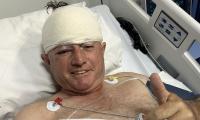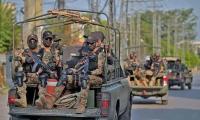ISLAMABAD: The Senate was informed on Wednesday that a total of 266,412 Pakistanis were deported during the last three years with largest number of them from Saudi Arabia.
During the Question-Hour, Federal Minister for Interior Ch Nisar Ali Khan in a written reply to a question by Senator Ch Tanvir Khan said that 78,409 persons were deported in 2014; 116,185 in 2015, and 71,818 in 2016. During this period, 175 Pakistanis were deported from Iran, 30 from Afghanistan and 27 from India.
Primary reasons for their deportation have been overstay, loss of passport / passport retained by kafeel (employer), illegal immigration, entry refusal and fake documents. From the United Arab Emirates, 8,434 were deported in 2014, 8,690 in 2015 and 1,352 in 2016.
Replying to queries, Minister of State for Interior Muhammad Balighur Rehman said that majority of those ‘returned’ traveled by by air, whereas 4,956 were deported from Iran in 2014, 26,978 in 2015 and 16,159 in 2016 via land, whereas 1,920 ‘returned’ via sea from Oman in 2014 and none in the next two years.
The minister said that on the directions from the prime minister, a number of measures have been taken to arrest this trend and the results so far have been promising. To another question from PPP’s Ahmad Hassan, the minister pointed out that for the first time, mapping and survey of the land of the Capital Development Authority (CDA) had been launched along with satellite imaging to find out how much of it was under illegal occupation and adverse occupation. In the light of that, full action would be taken against the occupiers with zero tolerance for this menace.
He explained that the prime minister had taken notice of the occupation of CDA land and the CDA chairman was also focusing on this issue. He added that a CDA official had gone on Wednesday for demarcation of the land belonging to the Quaid-i-Azam University.
Senators Dr. Jehanzeb Jamaldeni of BNP-Mengal, Ahmad Hassan of PPP and Ch. Tanvir Khan of PML-N came hard on CDA for closing its eyes to land grabbers, whereas MQM’s Tahir Hussain Mashhadi went ahead to allege that this illegal occupation of precious CDA land was impossible without the involvement of CDA officials and wanted action against them.
Senator Ch. Tanvir agitated on provision of incomplete information to his questions regarding military hospitals and combined military hospitals working under the administrative control of the armed forces. He said his question was previously not replied and now the information provided was incomplete.
On his request, Deputy Chairman Senate Maulana Abdul Ghafoor Haideri, who conducted the Question-Hour, deferred the question. The information shared in writing with the House included there were as many as 45 hospitals under the army, which included three 1,000-bed, one 700-bed, four 600-bed, two 500-bed and seven 400-bed hospitals.
The hospitals under the control of the Pakistan Air Force stood at eight and the Pakistan Navy’s four. Hence, the total beds of at the army hospitals is 13,500, 1,057 at the naval hospitals and 1,405 at the Pakistan Air Force hospitals.
The total budget for these hospitals in the year 2015-2016 was Rs8.27 billion. The remaining information is being collected and would be shared with the House. Minister for Railways Khawaja Saad Rafique told the House that from May 2013 to December 31, 2016, a total of 25 fatal/serious accidents occurred in which loss of life or injury was mainly due to fault of railway employees: out of these, 17 accidents occurred due to human error of railway employees; seven accidents were related to sabotage activities while one occurred due to natural calamity.
The number of persons who lost lives due to accidents, stemming from human error, was 94 while another 413 were injured. He said the SOPs, the department followed, were good but dated back to 125 years and the ministry was presently working on a number of key measures to massively cut down number of accidents.
Khawar Manika's counsel continued his arguments on Wednesday in a petition filed by Imran Khan and Bushra Bibi
IHC reserved judgment on the petition against registration of cases against former interior minister Sheikh Rashid on...
Saudi woman who was reportedly kidnapped from Islamabad’s residential Sector F-8 in mysterious circumstances, has...
Pakistan Navy warship rescued 8 Iranian fishermen after their boat caught fire in the open sea
SC dismissed appeal against SHC order that turned down application of partner seeking extension of time to furnish...
Executive board of International Monetary Fund will meet on April 29 to discuss the approval of $1.1 billion funding...







